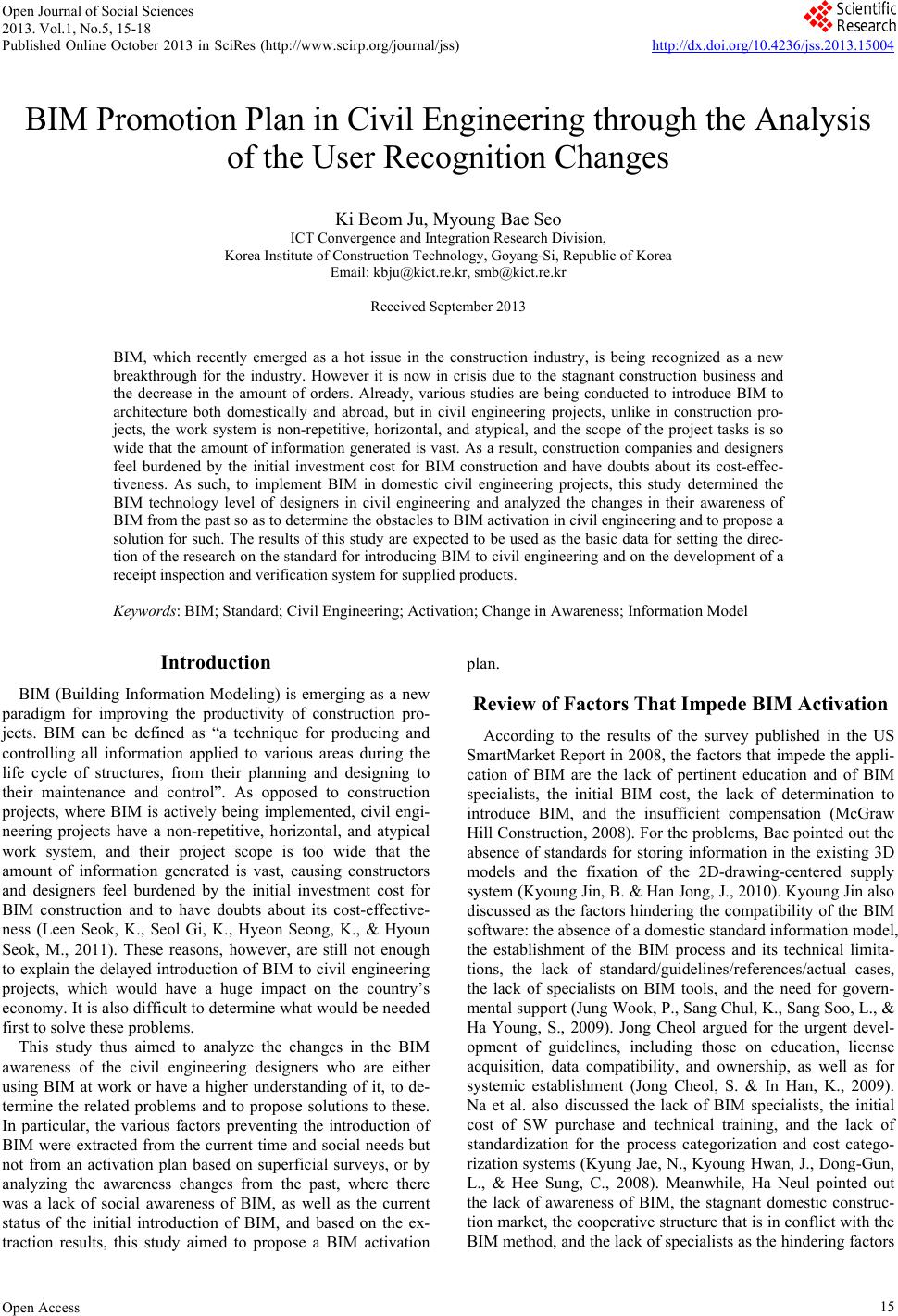
Open Journal of Social Sciences
2013. Vol.1, No.5, 15-18
Published Online October 2013 in SciRes (http://www.scirp.org/journal/jss) http://dx.doi.org/10.4236/jss.2013.15004
Open Access 15
BIM Promotion Plan in Civil Engineering through the Analysis
of the User Recognition Changes
Ki Beom Ju, Myoung Bae Seo
ICT Convergence and Integration Research Division,
Korea Institute of Construction Technology, Goyang-Si, Republic of Korea
Email: kbju@kict.re.kr, smb@kict.re.kr
Received September 2013
BIM, which recently emerged as a hot issue in the construction industry, is being recognized as a new
breakthrough for the industry. However it is now in crisis due to the stagnant construction business and
the decrease in the amount of orders. Already, various studies are being conducted to introduce BIM to
architecture both domestically and abroad, but in civil engineering projects, unlike in construction pro-
jects, the work system is non-repetitive, horizontal, and atypical, and the scope of the project tasks is so
wide that the amount of information generated is vast. As a result, construction companies and designers
feel burdened by the initial investment cost for BIM construction and have doubts about its cost-effec-
tiveness. As such, to implement BIM in domestic civil engineering projects, this study determined the
BIM technology level of designers in civil engineering and analyzed the changes in their awareness of
BIM from the past so as to determine the obstacles to BIM activation in civil engineering and to propose a
solution for such. The results of this study are expected to be used as the basic data for setting the direc-
tion of the research on the standard for introducing BIM to civil engineering and on the development of a
receipt inspection and verification system for supplied products.
Keywords: BIM; Standard; Civil Engineering; Activation; Change in Awareness; Information Model
Introduction
BIM (Building Information Modeling) is emerging as a new
paradigm for improving the productivity of construction pro-
jects. BIM can be defined as “a technique for producing and
controlling all information applied to various areas during the
life cycle of structures, from their planning and designing to
their maintenance and control”. As opposed to construction
projects, where BIM is actively being implemented, civil engi-
neering projects have a non-repetitive, horizontal, and atypical
work system, and their project scope is too wide that the
amount of information generated is vast, causing constructors
and designers feel burdened by the initial investment cost for
BIM construction and to have doubts about its cost-effective-
ness (Leen Seok, K., Seol Gi, K., Hyeon Seong, K., & Hyoun
Seok, M., 2011). These reasons, however, are still not enough
to explain the delayed introduction of BIM to civil engineering
projects, which would have a huge impact on the country’s
economy. It is also difficult to determine what would be needed
first to solve these problems.
This study thus aimed to analyze the changes in the BIM
awareness of the civil engineering designers who are either
using BIM at work or have a higher understanding of it, to de-
termine the related problems and to propose solutions to these.
In particular, the various factors preventing the introduction of
BIM were extracted from the current time and social needs but
not from an activation plan based on superficial surveys, or by
analyzing the awareness changes from the past, where there
was a lack of social awareness of BIM, as well as the current
status of the initial introduction of BIM, and based on the ex-
traction results, this study aimed to propose a BIM activation
plan.
Review of Factors That Impede BIM Activation
According to the results of the survey published in the US
SmartMarket Report in 2008, the factors that impede the appli-
cation of BIM are the lack of pertinent education and of BIM
specialists, the initial BIM cost, the lack of determination to
introduce BIM, and the insufficient compensation (McGraw
Hill Construction, 2008). For the problems, Bae pointed out the
absence of standards for storing information in the existing 3D
models and the fixation of the 2D-drawing-centered supply
system (Kyoung Jin, B. & Ha n Jong, J., 2010). Kyoung Jin also
discussed as the factors hindering the compatibility of the BIM
software: the absence of a domestic standard i nformation model,
the establishment of the BIM process and its technical limita-
tions, the lack of standard/guidelines/references/actual cases,
the lack of specialists on BIM tools, and the need for govern-
mental support (Jung Wook, P., Sang Chul, K., Sang Soo, L., &
Ha Young, S., 2009). Jong Cheol argued for the urgent devel-
opment of guidelines, including those on education, license
acquisition, data compatibility, and ownership, as well as for
systemic establishment (Jong Cheol, S. & In Han, K., 2009).
Na et al. also discussed the lack of BIM specialists, the initial
cost of SW purchase and technical training, and the lack of
standardization for the process categorization and cost catego-
rization systems (Kyung Jae, N., Ky oung Hwan, J., Dong-Gun,
L., & Hee Sung, C., 2008). Meanwhile, Ha Neul pointed out
the lack of awareness of BIM, the stagnant domestic construc-
tion market, the cooperative structure that is in conflict with the
BIM method, and the lack of specialists as the hindering factors